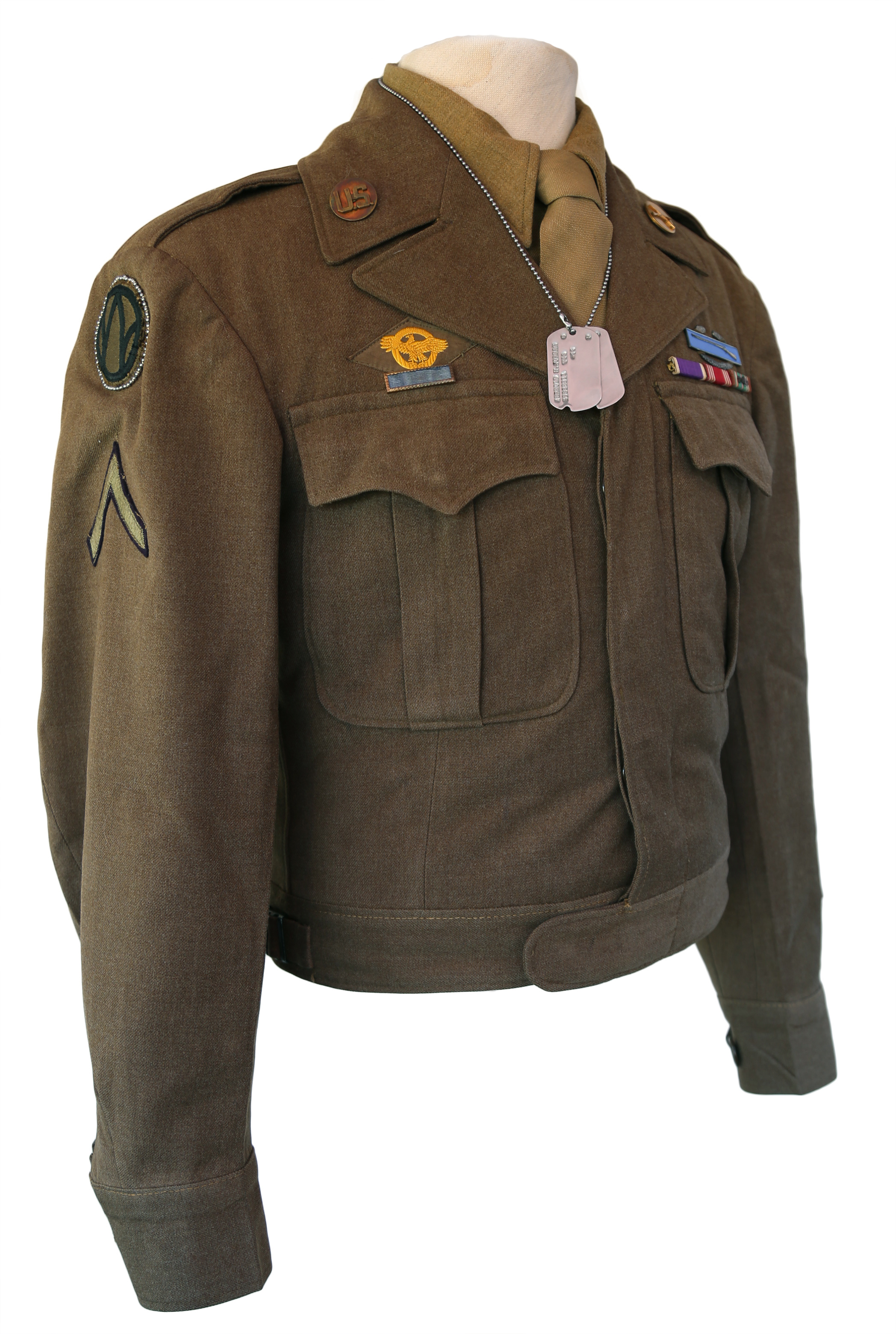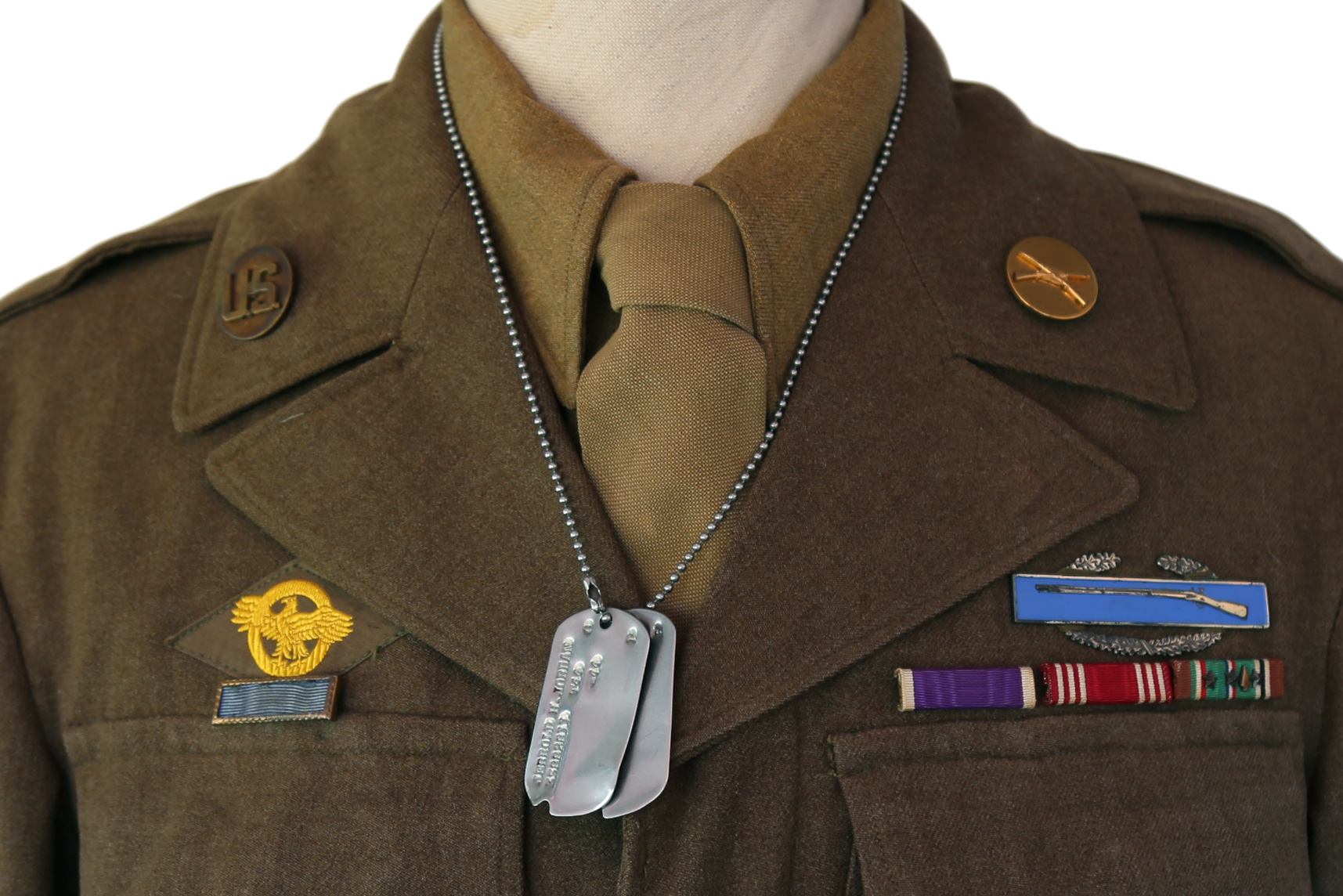WW2 Ike Jacket
Pfc. Jerrold H. Jordan - 89th & 83rd Infantry Division
This is a nice 83rd Infantry and 89th Infantry Division uniform identified to Pfc. Jerrold H. Jordan who served in combat with G Company, 354th Infantry Regiment, 89th Infantry Division. After VE-Day Pfc. Jordan was transferred to the 83rd Infantry Division to serve on the Occupation force in Germany together with many other veterans who did not have enough points to return home.
The Jacket still has the original insignia sewn to it, including on his left sleeve, the 83rd Infantry Division patch, private first class chevron, three Overseas Service Bars. On his right sleeve he has his former combat unit patch of the 89th Infantry Division and the private first class chevron. Both of the patches stand out because of the dogtag chain stitched around them. This was one of the practices done by veterans to 'enhance' the look of their uniform.
Above the right-hand pocket is his Ruptured Duck and a distinguished unit citation. Above the left-hand pocket there are Service Ribbons for the Purple Heart Medal, the Good Conduct Medal, the European African Middle-Eastern Campaign Medal with three Bronze Campaign Stars and one bronze arrowhead. This arrowhead indicates Pfc. Jerrold Jordan was part of the amphibious assault across the Rhine River carried out by the 89th Infantry Division on March 24, 1945. G Company landed on St. Goarshausen, Germany. The uniform set also includes Pfc. Jordan's dog tags.



Visible on the European African Middle Eastern Campaign Medal is the Arrowhead device awarded for the ampibious crossing of the Rhine River.
Pfc. Jerrold H. Jordan
Private First Class
Jerrold H. Jordan

Pfc. Jerrold Herman Jordan
Jerrold H. Jordan was born in Morgan, Ohio on October 3, 1925 to John and Ethel Jordan. He was drafted into the military and joined on January 7, 1944. As a new private he was assigned to G Company, 354th Infantry Regiment, 89th Infantry Division. The "Rolling W" as the 89th was nicknamed, landed in Le Havre, France on 24 January 1945. They remained at Camp Lucky Strike for about a month before moving to the Dieppe area. Finally, on March 5 the division received orders to move to Luxembourg where it took positions along the Moselle River. On March 15 the division crossed the Moselle River under German fire but was succesfully able to establish a bridgehead. For the 354th regiment this river crossing was largely conducted by 1st and 3rd battalions of the 354th with 2nd battalion (and thus G Co) in Regimental reserve. Having completed their baptism of fire the 89th Division now joined the Allied advance East through Germany towards the Rhine River.
On March 26, 1945 the 89th Infantry Division had reached the West bank of the Rhine River and orders came through the division would conduct an amphibious assault to establish a bridgehead on the East bank. The 354th Infantry Regiment was to cross at Sankt Goar, its objective Sankt Goarshausen on the East side of the river about 300 yards away. This time 2nd battalion would be the spearhead for the 354th Regiment's crossing. The assault was kicked off by E and F companies at 0200 on March 26. The assault boats were hit hard by machine gun fire and 20mm rounds fired low over the water level. The defending Germans lit barges on fire lighting up the river and taking away the cover of darkness for the men trying to cross. Despite heavy resistance from the Germans elements of both companies made it across and were able to establish a bridgehead.
G Company, which had been in 2nd battalion reserve, started making their crossing of the river shortly after daylight. Resistance was still strong and the boats were hit hard by 20mm fire coming from the steep hills surrounding Sankt Goarshausen. Thanks to the determination of the soldiers, and the support from machine gun and artillery fire, G Co only lost 3 killed and 13 wounded during the crossing itself. Capt. Oberstein, G Co CO later said: "The outstanding fact about the crossing," Co. G's commander, Capt. John W. Otterbein, said afterwards, "was the courage of the men under fire. Despite the fact that they could see what was happening to their comrades, the succeeding waves of men pushed their boats into the water with clocklike precision. There was not a moment's hesitation on the part of any man. That, to my mind, is heroic." (from the 354th Unit History online available at www.89thinfdivww2.org)
Hospital records reveal that Pfc. Jerrold Jordan was wounded in action on March 26, 1945, the day of the Rhine river crossing. It is unclear whether he sustained these wounds during the murderous crossing or later on that day while G Company continued fighting through Sankt Goarshausen. What is clear however is that these wounds would mean the end to Pfc. Jordan's combat service only returning to his unit in early May 1945, mere days before VE-day. The division stayed in Germany on occupation duty for the remainder of May before being reassigned to Camp Lucky Strike in Le Havre, France. Here they took over the duties of processing soldiers returning to the US, while the 89th itself was dismantled and high-pointers were able to return home.
Pfc. Jerrold Jordan was one of the many thousand GIs who had not accumulated enough 'points' after the war was over. Together with 9000 other members of the 89th he was transferred to the 83rd Infantry Division in September 1945 and again transported to Germany for occupation duty. He would remain in this capacity for several more months and only return to the US in 1946, receiving an honorable discharge on May 12, 1946. Only a few months later he married Marion Lyons. Jerrold H. Jordan lived in Ohio for the remainder of his life and passed away on January 15, 1997, age 71.